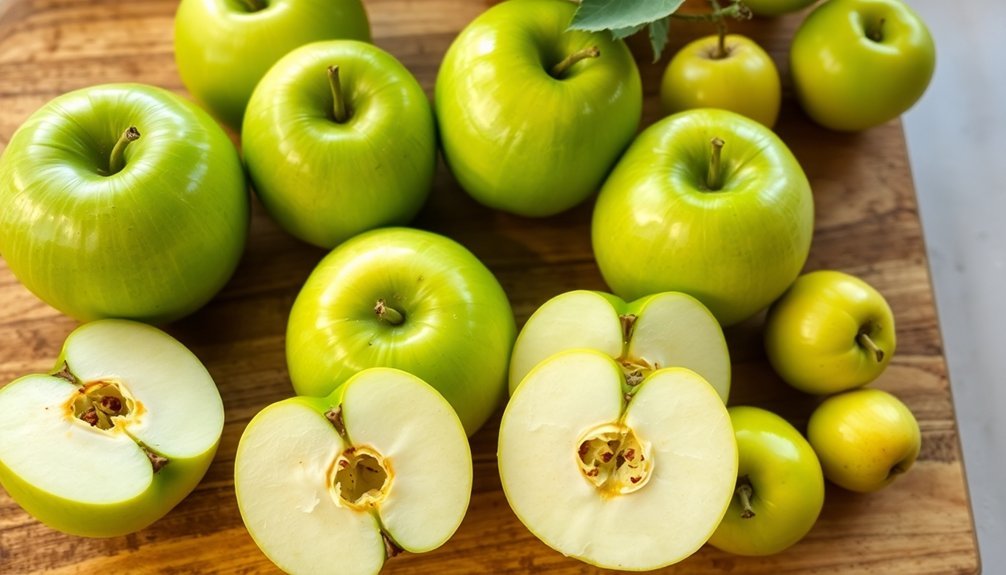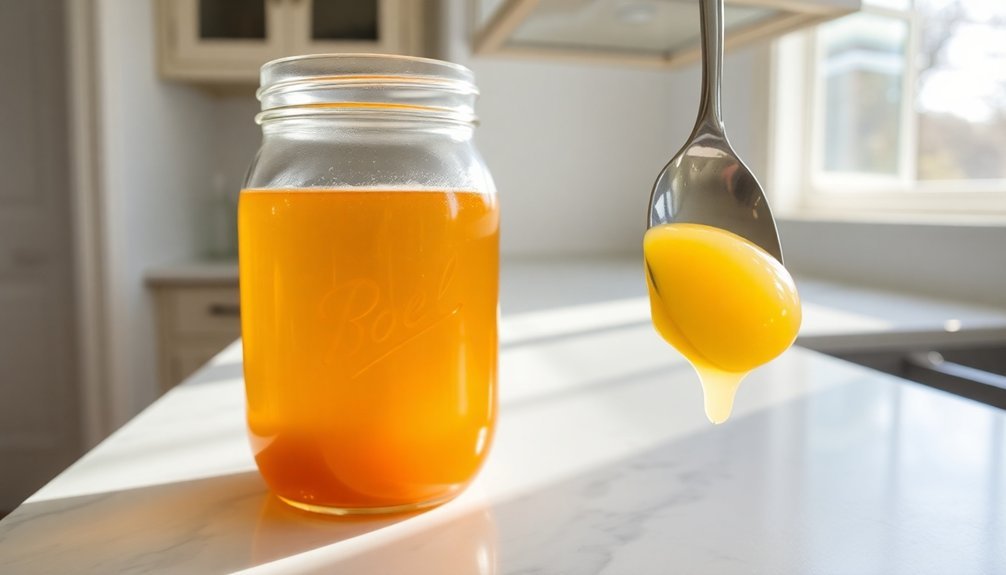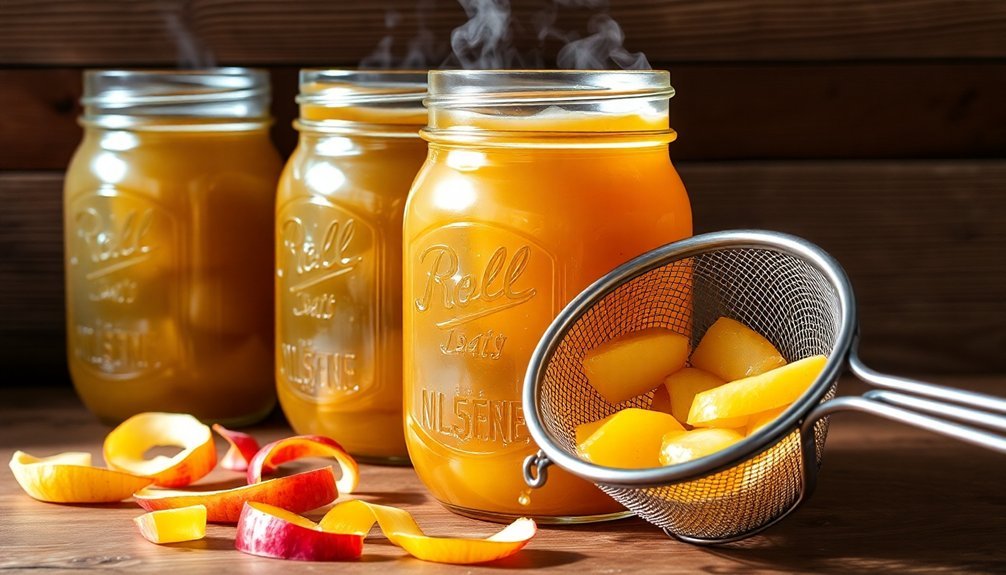To make homemade apple pectin, start with under-ripe Granny Smith or crab apples, which contain the highest pectin levels. Don't discard the peels and cores – they're packed with pectin too. For extraction, simmer your apple materials in water for 30-90 minutes at medium heat, maintaining a 1:30 ratio of apple to water. You'll know your pectin is ready when a spoonful forms a solid glob in rubbing alcohol. These basic steps will help you create natural pectin for your jams and jellies, and there's plenty more to discover about perfecting your preservation technique.
Choose the Right Apples

When it comes to making homemade apple pectin, selecting the right apples makes all the difference in your final product. You'll want to focus on sour and tart varieties, as they contain higher levels of natural pectin. Granny Smith, Shamrock, Lodi, Red Island Green, and Newton Pippin are excellent choices for your pectin-making endeavors. Crab apples are another fantastic option due to their exceptionally high pectin content.
The ripeness of your apples plays a vital role. Choose under-ripe or green apples, as they'll yield more pectin than their fully ripened counterparts. Look for firm apples that haven't fully matured, and don't hesitate to use early-season drops.
If you can't process them immediately, you can freeze your apples until you've collected enough for a batch.
For the best quality pectin, opt for organic apples whenever possible. You'll avoid the pesticides that often linger on conventional apple skins, ensuring a cleaner end product.
Remember to use all parts of the apple – the peels, cores, and seeds contain significant amounts of pectin. You can collect and freeze these scraps until you're ready to make your pectin, maximizing both efficiency and yield while reducing waste.
Extracting Maximum Pectin
Extracting pectin from apples requires careful attention to temperature, pH levels, and timing to maximize your yield. For the best results at home, you'll want to maintain temperatures between 75-95°C during the extraction process. If you're using citric acid, which is the safest option for home use, aim for a pH between 1.2 and 3.3.
You'll need to simmer your apple materials in the acidic solution using the right liquid-to-solid ratio. Don't add too much water, as this can dilute your pectin. A ratio of 1:30 (apple material to water) typically works well. Plan to simmer for 30-90 minutes, checking the consistency periodically. Apple pomace contains 18-30% pectin content, making it an excellent source for home extraction.
To boost your extraction efficiency, you can combine methods. Try using brief bursts in the microwave before simmering, as this can enhance the pectin's antioxidant properties and stability.
If you're feeling adventurous, you might experiment with enzyme-assisted extraction, which operates at lower temperatures (around 25°C) and can yield more pectin than traditional acid extraction. Just remember that timing is essential – longer isn't always better, as over-extraction can break down the pectin's structure.
Testing Pectin Strength

Throughout the process of making homemade pectin, testing its strength becomes essential for successful preservation projects. You'll find that the simplest and most practical method involves using rubbing alcohol to evaluate the pectin's jelling potential. Pour a spoonful of your pectin into rubbing alcohol and observe how it coagulates – if it forms a heaping gob on your fork, you've achieved the perfect concentration.
For different fruit combinations, you'll need to adjust your approach. When working with:
- High-pectin fruits: You can reduce boiling time and use less pectin
- Low-pectin fruits: Boil down to match the pectin volume
- All fruit types: Keep stirring continuously to preserve flavor
While professional manufacturers use sophisticated methods like the USA-SAG system and pectinometers to measure breaking strength and gel viscosity, you don't need complex equipment at home. Regular testing helps maintain quality standards in home preservation. Instead, focus on practical indicators – if your pectin forms a firm jelly-like mass when mixed with fruit juice, you're on the right track.
Remember to test throughout the cooking process, as this helps you achieve the ideal consistency for your preserves without overprocessing.
Frequently Asked Questions
Can Homemade Apple Pectin Be Frozen Instead of Canned?
Yes, you can freeze homemade apple pectin instead of canning it. Just use freezer-safe containers or ice cube trays, and it'll stay good for up to a year while maintaining its gelling properties.
How Long Does Homemade Apple Pectin Last When Properly Stored?
You'll get the best results using homemade pectin within 6-8 months. If you've frozen it, it'll last longer, while refrigerated pectin stays good for 6 weeks. Canned pectin should be used within a few months.
Can Other Fruits Be Combined With Apples to Make Pectin?
Yes, you can combine citrus fruits, quince, pears, or plums with apples to make pectin. Using fruit scraps like apple peels, cores, and citrus rinds together creates a robust pectin while reducing waste.
What Causes Pectin to Fail to Set Properly in Jellies?
Your jelly won't set properly if you've used incorrect sugar proportions, overcooked the mixture, measured ingredients imprecisely, or chosen overripe fruits. Poor temperature control and improper boiling techniques can also cause setting failures.
Is Homemade Apple Pectin Safe for Diabetic-Friendly Jam Recipes?
Yes, you'll find homemade apple pectin is safe and beneficial for diabetic-friendly jams. It actually helps slow down sugar absorption, stabilizes blood sugar levels, and improves glucose tolerance while requiring less sugar in recipes.
In Summary
Now you're ready to make your own apple pectin at home! You'll save money while having complete control over your jam and jelly ingredients. Don't forget to store your homemade pectin in sterilized jars and keep them in a cool, dark place. Once you've mastered these simple steps, you'll never need to buy commercial pectin again. Start experimenting with different apple varieties to find your perfect blend.





Leave a Reply